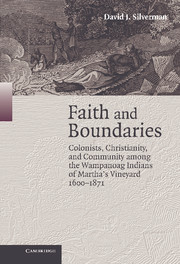 Faith and Boundaries
Faith and Boundaries Published online by Cambridge University Press: 17 December 2010
Blood boiled at Aquinnah in 1812 when news broke that Zachariah Howwoswee Jr. and Simon Mayhew had submitted a petition to Boston claiming to represent the ten so-called “few remaining Indians of Gayhead.” In it they asserted that the Wampanoags “used to get along quite peaceably and well … [but] now there are so many Negroes and Molattoes got in among us, who are proud, lazy, and do not do right, and hurt us very much, & we cannot help ourselves.” The only way to protect the besieged Natives, Howwoswee and Mayhew contended, was for Massachusetts to place Aquinnah under new guardians, namely themselves. These underhanded men had attempted several land grabs over the last twenty years, only to be defeated at every turn. Now, with Howwoswee sunken in debt and Mayhew overconfident following his election as Chilmark's representative to the state legislature, they hatched this new scheme with the obvious purpose of engrossing Wampanoag territory.
Aquinnah professed shock at the petition's “absurditites,” but no one could have been surprised that race had finally entered the community's politics. Recently, a stark shortage of Indian men had forced growing numbers of Indian women to marry outsiders, a disproportionate number of whom were “blacks” and “mulattoes” since segregationist workplace conditions, laws, and customs grouped Natives with other “people of color.” Although there were scattered examples of Wampanoags pairing with African American slaves stretching back several years, this was the first time open marriages took places in such large numbers, thereby presenting the Indian communities in which the “mixed” couples lived with a host of formidable challenges: Could a non-Indian participate in local government?
To save this book to your Kindle, first ensure [email protected] is added to your Approved Personal Document E-mail List under your Personal Document Settings on the Manage Your Content and Devices page of your Amazon account. Then enter the ‘name’ part of your Kindle email address below. Find out more about saving to your Kindle.
Note you can select to save to either the @free.kindle.com or @kindle.com variations. ‘@free.kindle.com’ emails are free but can only be saved to your device when it is connected to wi-fi. ‘@kindle.com’ emails can be delivered even when you are not connected to wi-fi, but note that service fees apply.
Find out more about the Kindle Personal Document Service.
To save content items to your account, please confirm that you agree to abide by our usage policies. If this is the first time you use this feature, you will be asked to authorise Cambridge Core to connect with your account. Find out more about saving content to Dropbox.
To save content items to your account, please confirm that you agree to abide by our usage policies. If this is the first time you use this feature, you will be asked to authorise Cambridge Core to connect with your account. Find out more about saving content to Google Drive.